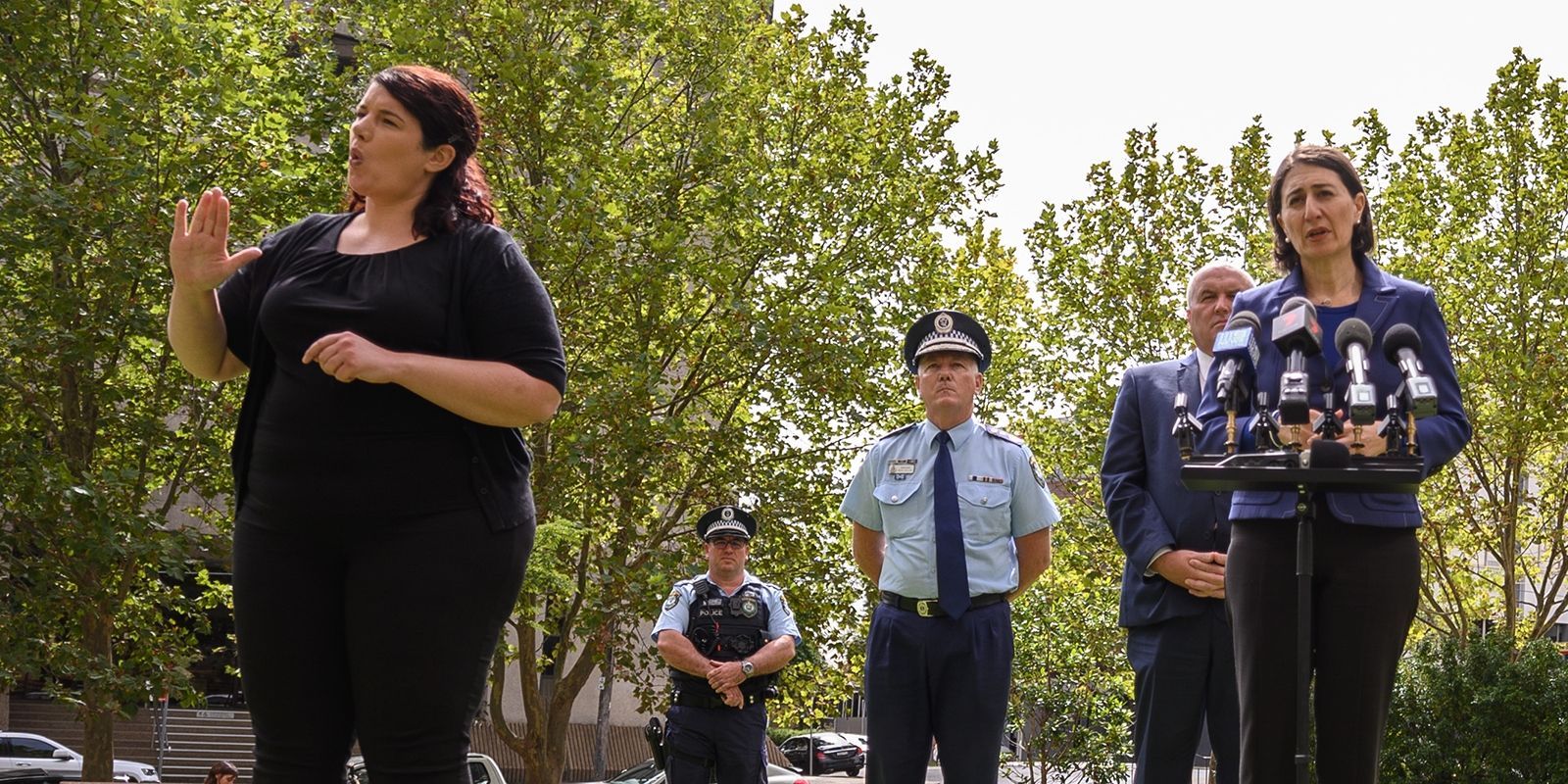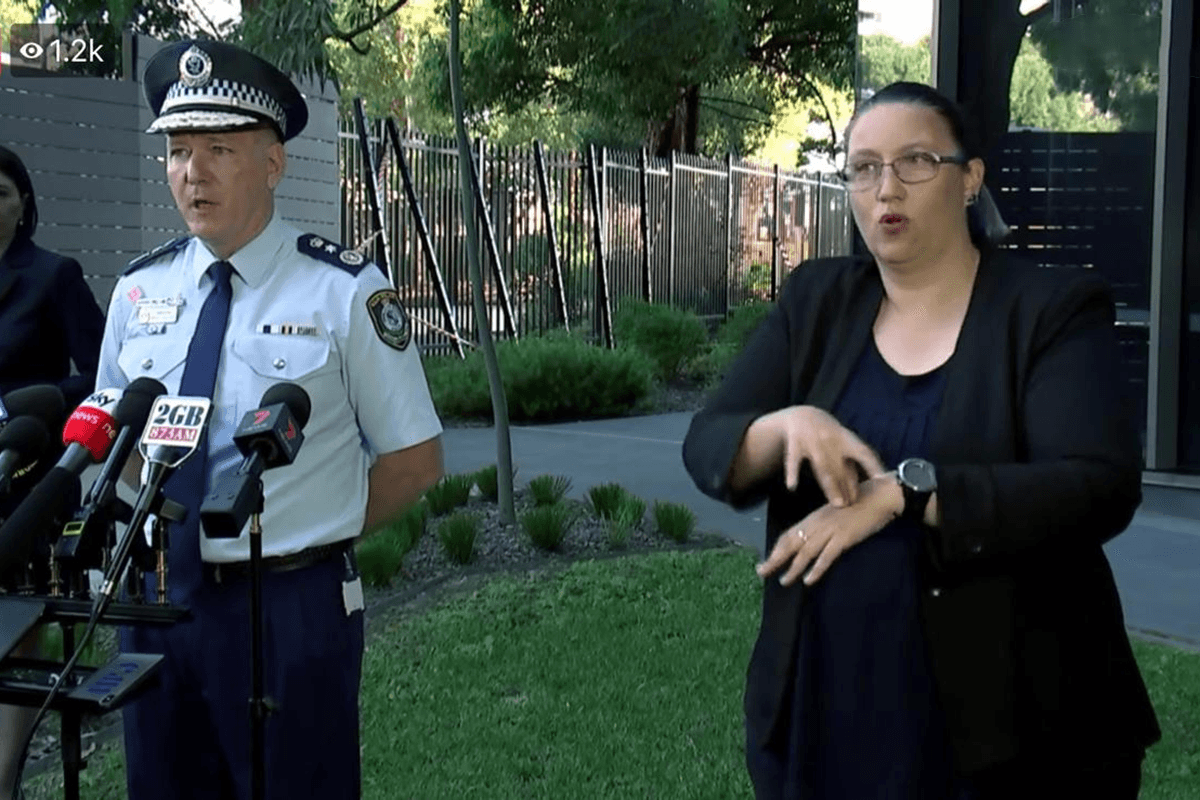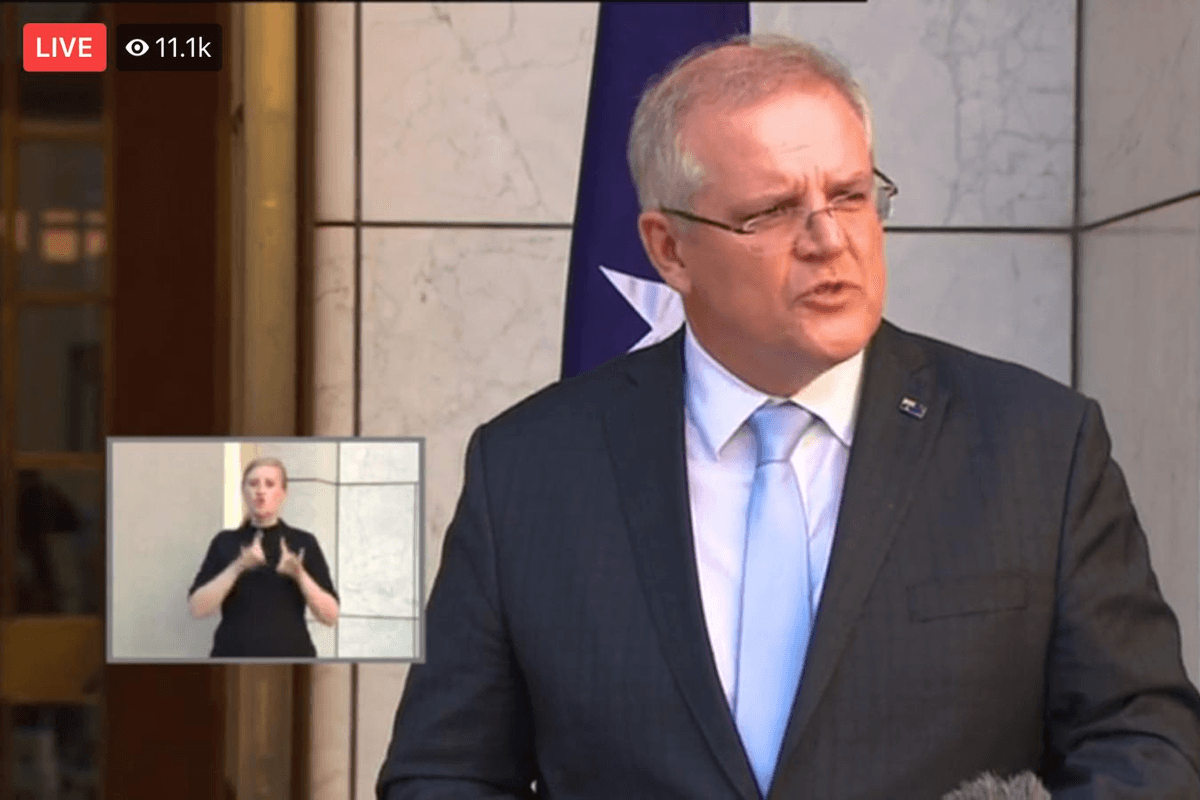A Sign for the Times: Interpreting as a Team

On 1 October 2020, QLD-based Deaf Services and NSW-based The Deaf Society will merge, building on a long history between the two organisations delivering the Australian Deaf community many benefits and services, including improved access to Auslan interpreting.
This has been most apparent during the coronavirus pandemic, with Auslan interpreters sharing the screen with health officials and politicians, ensuring the critical and rapidly changing information during this time of national crisis was understood by Australia’s Deaf community.
We caught up with the Deaf Society Interpreting Services team to find out how they have adapted to the new challenges arising from COVID-19, and why it’s more important than ever to ensure government broadcasts include accurate and timely information in Auslan.
What is your usual preparation for a Press Conference?
We keep ABC News on the television 24/7 and also read the latest articles posted on their sites. We watch press conferences from the previous days to ensure we are up to date with information. If we are interpreting for a government representative, we find clips on Facebook of the morning announcements from other government representatives made earlier that day. Any terms or phrases that haven’t been mentioned before are noted and researched. Then as a team, we brainstorm the best way to sign some of the more difficult concepts in our WhatsApp group.
How much notice do you get?
Sometimes days, sometimes 15 minutes.
How much information or preparation do you get or receive access to before a broadcast goes “live”?
We spend a lot of our time trawling the news and trying to speculate what topics might be included in the press conference that we are interpreting for. From there, we will work as a team to discuss any new terms we are expecting might come up. Our team also support each other by posting relevant news articles or clips from other press conferences that might help us in our preparation.
The amount of formal briefing we receive varies from day to day and between government agencies. Some departments will regularly include us in their sit down briefing sessions with the figureheads who will be speaking at the presser. Some departments will give us a one page press briefing. Either way, we always make sure to be prepared
If we arrive on scene and are waiting for the officials to arrive, we try to chat to some of the journalists. Sometimes they are happy to share some pre prepared questions they may have. This is immensely helpful because often the questions are the hardest part of a press conference!

Are you provided with any additional training specific to Emergency Broadcasts?
There was a preliminary training session held in Melbourne in 2017 that three people from each state got to attend. Later that year, the Deaf Society held their own training session so that more people could attend. The Deaf Society provided another training day at the start of 2020. Given the ongoing and ever-changing landscape of COVID-19, the team are now supporting each other daily with preparation and feedback on work done. We also meet at least once a week on Zoom for additional training and debrief sessions.
What are common motivations for wanting to be an Auslan interpreter?
People are motivated to become Auslan interpreters for a variety of reasons. It could be that they are native signers, Auslan is their first language, due to having Deaf family. They could have come in contact with a Deaf person at some point during their lives which motivated them to learn the language and then become an interpreter. More and more now, we are seeing people choose this career path simply because they have seen a Deaf person or an interpreter on television or social media and it inspires them to learn the language. We hope the increased exposure of interpreters on television during this current crisis will inspire many more people to choose Auslan Interpreter as their future career.
Is interpreting Press Conferences something that many interpreters want to undertake?
No. Most interpreters don’t enjoy working in the spotlight. Covid-19 has impacted everyone in one way or another. Never before have we witnessed something with such a far-reaching impact which is likely to continue for such a stretch of time. We do this work because Deaf people need to receive this information in order to keep themselves and their families safe. For us, it’s about ensuring equitable access.
What has most surprised you about interpreting Emergency Broadcasts?
How much work goes into organising a press briefing. The staff we encounter at the emergency services and government departments are all working around the clock to provide the most up to date information for the community.
Sometimes we are not in the room with the speakers. Sometimes we are in an entirely different location with just a camera operator and a video feed. Being in a separate location can be harder to work in as we miss out on the energy that is in the room with the speakers.
Many people who see us on TV think this is the only type of interpreting we do! They don’t realise that we spend every day going to people’s staff meetings and training sessions, doctor’s appointments, school meetings and social events. Emergency broadcasts are actually a very small percentage of the work we do each day.
With Auslan interpreting becoming more present in the lives of all Australians, what are some things you think non Auslan users should understand about the language?
That Auslan is a language in its own right with its own grammatical structure that is different to English structure. Facial expressions are used to convey the tone and intonation of the speaker. Some facial expressions or handshapes do not mean what you might think, and it’s often counterproductive when people jump to conclusions about what signs mean.
Another thing non Auslan users often don’t understand is that interpreting between two languages is extremely difficult. Especially simultaneous interpreting – interpreting at the same time as the speaker is speaking. We have only a second to hear the information, work out the meaning and how to convey that in the other language and then produce it, at the same time as taking in the next piece of information.
People often comment about how lovely we look when we work, but it is physically and mentally exhausting – even more so when you’re interpreting for the Prime Minister or Premier during a pandemic…

What was the experience like of interpreting your first Press Conference?
Nervous! Usually, we can see the face of our deaf clients when we interpret for them. This type of work is different as we can’t see the deaf customer watching on their television or phone from home. We try to imagine a deaf person that we know sitting inside the camera barrel so that we have someone to interpret the message to. The current situation has brought additional challenges to the broadcasts also. The majority of briefings are now held outside and we have to stand 1.5 metres away from the speaker. Given the background noise of vehicles, people and whether it can make it very difficult to hear the speaker.
What is the biggest difference between “day-to-day” interpreting and interpreting a press conference or EB?
In “day-to-day” interpreting we know our audience. They are sitting across from us and engaging with the message. We are able to gauge their understanding by their facial expression and body language.
When interpreting an Emergency Broadcast we have a large unseen audience, with a wide variety of language needs. As interpreters, we want to relay the information being given in a way that caters to as many deaf viewers as possible.
Do you think about the size of the audience you are potentially interpreting to during a PC/EB?
Yes. We think about the variety of language needs of the audience and try to cater for as many as possible with our sign choices. The hardest part is that we cannot control the words coming out of the speaker’s mouth. If the person speaking is not using full sentences and clear language, then our interpretation is also not clear.
Have you ever been recognised from your work as an interpreter, especially from PC/EB?
Yes. We try to smile and change the subject as it makes most of us uncomfortable. We don’t do this work for recognition. We would much prefer giving air space to deaf people who benefit from having interpreters on PC/EB rather than from interpreters doing the work.
How has interpreting during COVID-19 changed the way you work?
After spending so much time in a tiny little PIP (picture-in-picture) box in the corner of a screen, we find that we are consciously signing slower and larger in our everyday interpreting. With the current pandemic, our “day-to-day” interpreting is mostly taking place remotely on internet video platforms, and so we hope that this practice makes for more comfortable viewing for our clients.
What more do you think can be done to deliver important information to the Deaf community, especially during this time?
It would be great to see the various organisations have more of their online content interpreted into Auslan. We have been translating many of the FAQs that are posted on various websites. This empowers deaf people to get the information they need directly from a trusted source.
We have also seen some great resources being put out by deaf people summarising important information from the media. We believe that this deaf-to-deaf information sharing is vital to ensure the whole community gets the information it needs. Many service agencies, such as the Deaf Society, are also posting daily summary videos on their social media pages. We are seeing interpreters and deaf people working together to deliver information across the Deaf community and we hope that we continue to build on this in the future.
